YOU ARE HERE >> AmazingRibs » Ratings & Reviews » Ratings Reviews And Buying Guides » Best Thermometers For Food And Cooking » How to Buy the Best In-Food/In-Cooker Thermometer » FireBoard FBX11 Review
FireBoard FBX11 Review
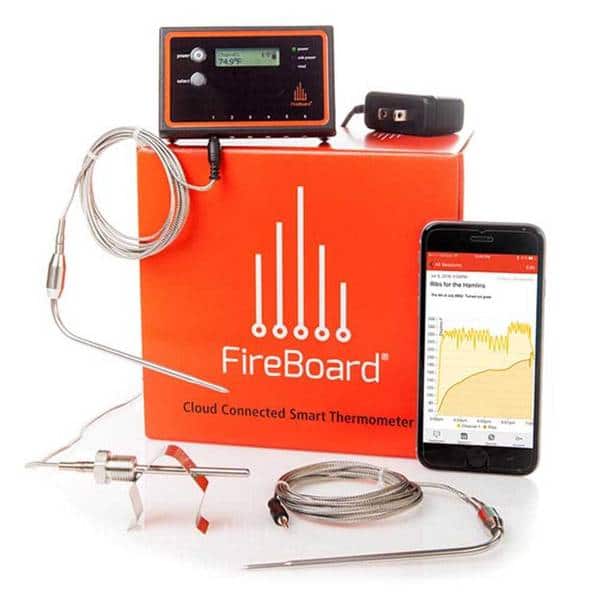
FireBoard has set a new standard in food thermometry. It is a new thermometer by a new company and it has gotten off to a scorching start. Its first offering is a very clever device sure to please serious cooks, competitors, restaurateurs, and caterers. It is a remote read, cloud connected, data logger, with connections for up to six probes. What’s all that mean?
Remote read means that you can plug probes into the meter and it will send the info to your smartphone, tablet, or Amazon Alexa, so you can watch the progress of your cook from indoors or while you are cutting the lawn. You can see when your coals are dying, or estimate how long it will be until the meat is done. It uses either Bluetooth 4.0 (BLE) with a 100 foot range or WiFi depending on which is available.
Cloud connected means that you are not restricted by the short range of Bluetooth or even the longer range of radio frequency. Bluetooth may be the method of choice when you are in a park at a BBQ competition, but when you are home it will connect to your home’s WiFi. That means you can go to work downtown and follow the progress of your 12 hour brisket cook.
A data logger records the time and temp and about your cook so you can learn from it. The app shows a chart on your mobile device and if you are using WiFi the chart also appears under your account on their website in real time. On the website you can hover your mouse over the chart and it will tell you the exact temp at the exact time. You can even save charts for future reference, or download the data in a csv file that you can open in a spreadsheet or charting program if you want to create your own customized graph. FireBoard will even synchronize with the cloud after a power outage or if the connection goes down, or if you are out of range and using Bluetooth. That’s pretty amazing.
Six probes mean you can measure lots of things at once. For example, you can use one for measuring the air temp in your cooker and the other five for measuring five different pieces of meat. Or, if you want, you can measure four locations within one brisket and the air temp at the top and bottom of your cooker. That’s a lot of capability, more than any other device.
The meter is surprisingly small for all this capability, 4.5 ounces and about the size of a pack of cigarettes, less than half the size and weight of the Thermoworks Smoke. While Smoke has two ports for two probes, FireBoard has ports for six probes, another port for a USB connector that charges the device, and an 8 pin mini DIN auxiliary input port that at the moment has no function but could be used for accessories in the future, possibly a fan to control airflow to a fire and thus control temperature. If you leave it plugged in it will run forever while most of its competitors run only in battery mode and the batteries eventually die. There is a small LCD display that shows battery life, whether or not you are connected, and it cycles through the probe temps. It has a power button, a select button that allows you to select the probe that is being displayed, a small indicator light that tells you power is on, another that tells you if it is plugged into USB, and another that flashes every 5 seconds to confirm that the meter is polling the probes. The thermometer device itself is rated for 32°F to 113°F (0 to 45°C), however the manufacturer has done successful early testing in colder environments (down to approx. -10°F). We conducted some of our own tests at low ambient temperatures. In one, we ran the unit for 27 hours outside at temps that ranged from 19.5° to 29°F with no operational problems. Another test was conducted in a home freezer at 7°F with no problems. The unit will shut down automatically when the internal battery voltage reaches 3.2V, so there is no risk of completely depleting the battery.
The firmware can be updated, and, in fact, when I unpacked mine and fired it up it alerted me that there was an update. Yet another nice feature.
Probes are RTD PT-100 thermistors that have a reputation for accuracy, repeatability, and stability, and the temp range is said to be -94 to 752°F (-70 to 400°C). The manufacturer warns against exposing the cables to direct flames that can get hotter than 716°F and to be careful not to crimp them under the lid. Each probe has a 6’ long braided stainless steel cable, they appear to be solidly build, and, unlike many other manufacturers’ probes, can be submerged in water for washing. Another nice bit of cleverness: The air temp probe is threaded at the base so it can be mounted to the wall of your pit.
The app allows you to name and date each cooking session and type notes. Probes can be named (point or flat for example) or hidden and it can show the min/max for each probe. You can set alarms for when any of the probes hits a target temp and it can even send a text or email. Alarms can be customized so they only go off after a certain time, or if conditions last longer than a time you specify. Best of all, the app creates nifty charts of the cook that are really educational. They can be stored on your device and on the FireBoard website.
Here’s a chart for my Thanksgiving turkey (text in red was added later in Photoshop):
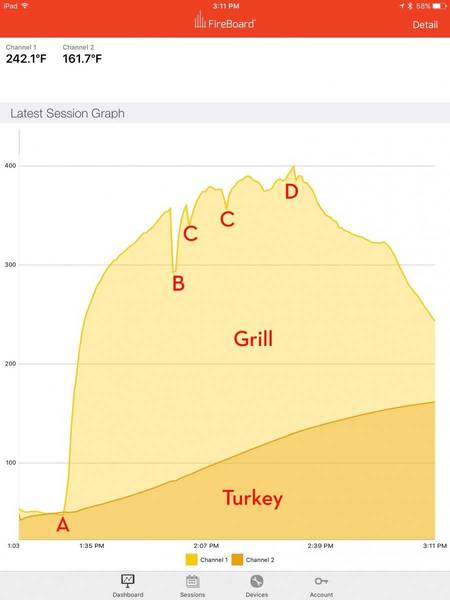
- I placed the 18 pound turkey on a Weber Kettle outfitted with a Slow ‘N Sear at 1:30 p.m. in the indirect heat zone and placed probe 1 on the cooking grate next to the meat, and inserted probe 2 into the breast. I was experimenting with charcoal made from coconut husks. They produced a lot of heat and very little smoke. The temp climbed steadily to 357°F at 1:57 (I usually shoot for 325°F).
- I lifted the lid for 1 minute and added a handful of wood to the coals. Air temp immediately dropped to 256°F but as soon as I put the lid on it went right back up. Notice also that the meat didn’t even notice the lid was off. So much for the old husband’s tale that if you’re lookin you ain’t cookin.
- At several points I checked the meat readings with handheld Thermapen and you can see the dips. FireBoard was right on the money.
- I normally like to cook turkey at 325°F but this coconut charcoal was burning hotter than I expected, peaking at 397°F at 2:30 but the meat was only 129°F. So I closed all the air vents, and air temp started down. I removed the bird at 161.7°F at about 3:11 p.m.
Initial setup is a snap. Download the free app, create an account, and configure it to your taste. Press the power button for 3 seconds. BLE Bluetooth does not need pairing if you don’t have WiFi, and if you do, the device easily found my WiFi network.
You can also use FireBoard to monitor your fridge, keep track of your brewing temps, calibrate your oven, and more. Here’s the chart of my indoor gas oven set for 350°F with two probes, one on the bottom rack, one on the top. The sinusoidal wave is typical of ovens because they switch on and off aiming for an average at the designated temp. Notice that my oven is running about 20°F hot, and that, surprisingly, the top shelf is hotter than the bottom.
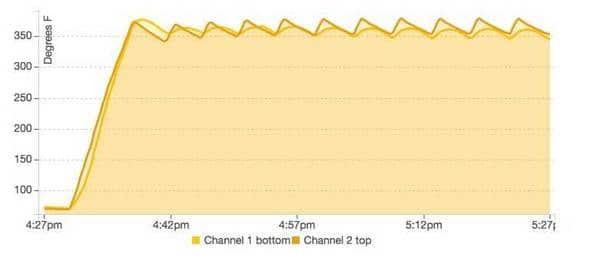
Complaints are few. If I wanted to be picky I would ask for more horizontal lines on the charts, for waterproofing (they say a case is in the works, but until then, you can use a plastic bag), and for it to be able to handle temps down to 15°F since I and a lot of good cooks don’t let a little freezing weather stop us (the owner says he has tested it at temps much lower than the official rating of 32°F of some of the components).
Pricing. Built in Kansas City, FireBoard sells two kits, a basic unit comes with the meter, charger, and three probes, two for meat and the other for air temperature, with a clip for the air temp probe for $189.
The Extreme BBQ kit comes with the meter and charger as well as two air temp probes, and 6 meat temp probes for $249. It comes with a 6 month limited warranty. Additional probes cost $15. There is also an auxiliary battery pack for $15 and a 6’ extension cord for probes for $7.
We’re giving the FireBoard a Platinum Medal for ease of use, quality of construction, and features.
Addendum:
Fireboard announced the availability of their “Competition Probes” recently. These come in two lengths: 3″ (77mm) and 1″ (25mm) and are much thinner than their other probes. I thought it would be interesting to test them and add the results to this review. Here are the numbers:
Actual Temp: Measured Temp:
32° 32.4°
130° 129.9°
225° 224.5°
325° 323.8°
As you can see, their accuracy is excellent. I wondered how quickly such thin probes might respond to rapid changes in temperature, making them potentially useful as instant read probes. The time to go from 32 to 212° was 15 seconds, and the time to go from 212 to 32° was 17 seconds. This response time is too slow to make them useful for quick reads, but that’s not what they were designed to do, anyway. In any case, these new probes will find themselves useful for people who want high accuracy and minimal entrance wounds. Check the manufacturer’s website for more information. Bill McGrath
Click the buttons below to search our complete database of reviews:
Product Information:
- Thermometer Function:Leave in Food, Leave in Cooker, Wireless Remote
- Item Price:$ 189.00
*Price Subject To Change - Where to buy (buying from this supplier supports this website):
- Probe:Cooker: 0.166 dia., 2.025" len., 6' cable (4.2mm dia., 55mm len., 1.8m cable) Food: 0.158" dia., 0.120" tip, 4.2" len,. 6' cable (4.0mm dia., 3mm tip, 10.7cm len., 1.8m cable)
- Battery Type:Li-Ion, Internal
- Battery Life:24 hrs, rechargeable
- Safe Operating Range:32 to 113ºF (0 to 45ºC)
- Min & Max Temp:-94 to 752ºF (-70 to 400ºC)
- Display Precision:0.1º
- Actual Temp at 32 Degrees:32.0, 32.3, 32.9
- Actual Temp at 130 Degrees:130.0,130.1,130.0
- Actual Temp at 225 Degrees:223.2, 224.7, 225.3
- Actual Temp at 325 Degrees:322.6, 324.6, 323.6
- Speed from 32 to 212 Degrees:n/a
- Numbers Display Size:Display dimensions: 0.375" x 1.375" (9.5 x 35mm)
- Water Resistance Rating:Not waterproof but covers will soon be available
- Weight:4.6 oz. (130g)
- C/F Switch:Built in CF switch
- Backlight:Built in Backlight
- Color Options:Black
- Thermometer Sensor:Thermistor
- App:Yes: iPhone, iPad, Android
- Logging:On portable devices and via browser
- Included:Controller, power supply, three probes, grill clip, instructions
- Available Accessories:Additional cables available on website or kit, probe extensions.
- Alarms:Audible/Visible
Fireboard Labs
Manufacturer:
Published On: 12/7/2016 Last Modified: 5/27/2022
-
Meathead, AmazingRibs.com Founder And BBQ Hall of Famer - Founder and publisher of AmazingRibs.com, Meathead is known as the site's Hedonism Evangelist and BBQ Whisperer. He is also the author of the New York Times Best Seller "Meathead, The Science of Great Barbecue and Grilling", and is a BBQ Hall Of Fame inductee.
Spotlight
These are not paid ads, they are a curated selection of products we love.
All of the products below have been tested and are highly recommended. Click here to read more about our review process.
Use Our Links To Help Keep Us Alive
Many merchants pay us a small referral fee when you click our “buy now” links. This has zero impact on the price you pay but helps support the site.
Why there is salt in our rub…
When you make rubs at home we recommend you add salt first then the herbs and spices because salt penetrates deep and the other stuff remains on the surface. So thick cuts need more salt. We put salt in these bottled rubs because all commercial rubs have salt and consumers expect it. You can still use these as a dry brine, just sprinkle the rub on well in advance to give the salt time to penetrate. For very thick cuts of meat, we recommend adding a bit more salt. Salt appears first in the ingredients list because the law says the order is by weight, not volume, and salt is a heavy rock.
Sprinkle on one tablespoon per pound of meat two hours or more before cooking if you can. Called “dry brining,” the salt gets wet, ionizes, becomes a brine, and slowly penetrates deep, enhancing flavor and juiciness while building a nice crusty “bark” on the surface. Sprinkle some on at the table too!
Are they hot? No! You can always add hot pepper flakes or Chipotle powder (my fave) in advance or at the table. But we left them mild so you can serve them to kids and Aunt Matilda
Ode to The Pitmaster Club
From TBoneJack, the unofficial Poet Laureate of The Pitmaster Club:
AmazingRibs is where you go,
To get the best advice,
You’ll find out how, to smoke a cow,
And it will turn out nice.
Smokers, gadgets, recipes,
Charcoal, gas, or wood?
The how, the why, and what to try,
When things arn’t going good.
Selection, prep, and cook techniques,
Marinades and such,
Rubs and brines and temps and times,
And how to use the Crutch.
Brisket secrets are revealed,
For moist and tender meat,
The point, the flat, the rendered fat,
The proper mix of heat.
I found out how to smoke spare ribs,
Great bark and taste and worth,
I want some more, I’ll have them for,
My last meal on this Earth.
Memphis Dust did suit them well,
I served them without sauce,
Not 3-2-1, not overdone,
No precious flavor loss.
Jambo, Lang, or Meadow Creek,
It’s hard to make the call,
Almost a crime, so little time,
I’d like to try them all.
I’m not ashamed, I’m not alone,
‘Cause many have this lot,
But I’ll admit, here in the Pit,
My wife said Not! Not! Not!
Weber, Brinkman, PBC,
No need for budget breach,
They cook great food, just ask me dude,
‘Cause I have one of each.
Obsessed I am, I know it’s true,
They call it MCS,
I saw the doc, he was in shock,
He too is in this mess.
Myron Mixon, Johnny Trigg,
Cool Smoke’s Tuffy Stone,
Harry Soo, Chris Lilly too,
And Moe who cooks alone.
They’re all good, I like them fine,
I’m sure they cook good Q,
They’ve earned the right, I see the light,
I’ll give them their fair due,
But I have learned, thru many cooks,
This web site is da bomb,
For what to do, browse over to,
AmazingRibs dot com.
Tired of seeing popup ads?
No need to throw a fit,
Don’t you know, just spend some dough,
And join us in the Pit.
And if you travel, don’t despair,
No further should you look,
The answer’s clear, put down your beer,
And order Meathead’s book.

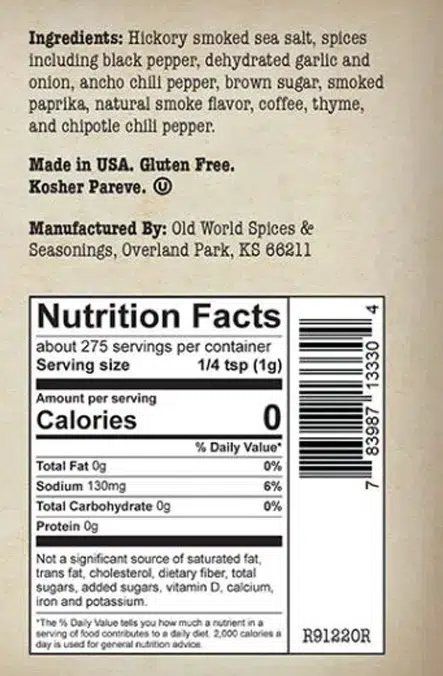
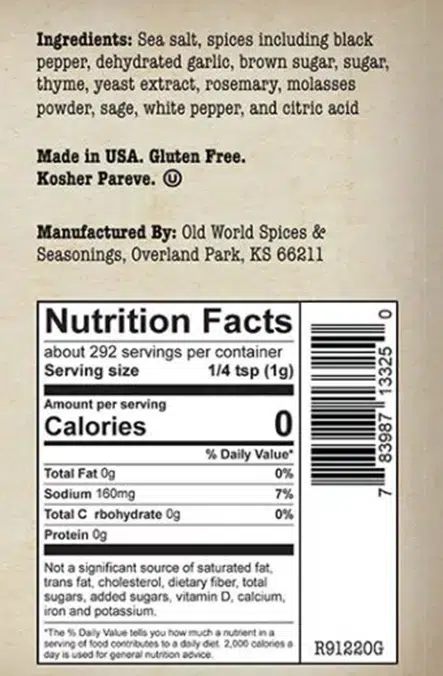
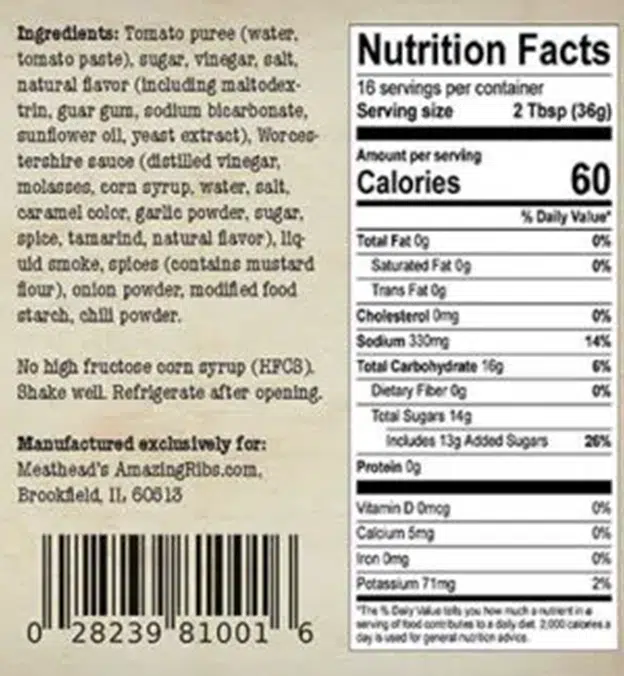
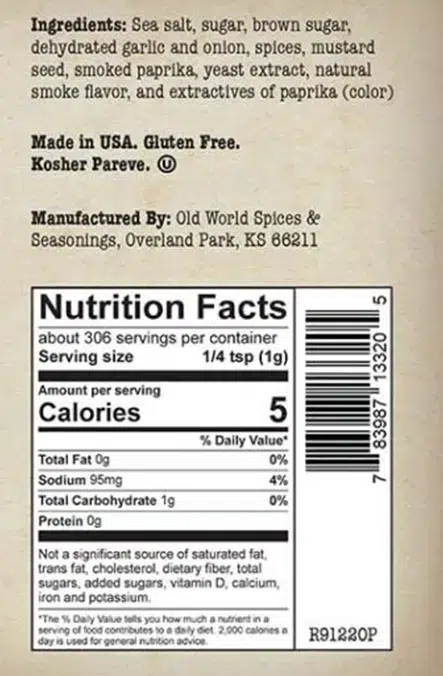
High quality websites are expensive to run. If you help us, we’ll pay you back bigtime with an ad-free experience and a lot of freebies!
Millions come to AmazingRibs.com every month for high quality tested recipes, tips on technique, science, mythbusting, product reviews, and inspiration. But it is expensive to run a website with more than 2,000 pages and we don’t have a big corporate partner to subsidize us.
Our most important source of sustenance is people who join our Pitmaster Club. But please don’t think of it as a donation. Members get MANY great benefits. We block all third-party ads, we give members free ebooks, magazines, interviews, webinars, more recipes, a monthly sweepstakes with prizes worth up to $2,000, discounts on products, and best of all a community of like-minded cooks free of flame wars. Click below to see all the benefits, take a free 30 day trial, and help keep this site alive.
Post comments and questions below
1) Please try the search box at the top of every page before you ask for help.
2) Try to post your question to the appropriate page.
3) Tell us everything we need to know to help such as the type of cooker and thermometer. Dial thermometers are often off by as much as 50°F so if you are not using a good digital thermometer we probably can’t help you with time and temp questions. Please read this article about thermometers.
4) If you are a member of the Pitmaster Club, your comments login is probably different.
5) Posts with links in them may not appear immediately.
Moderators